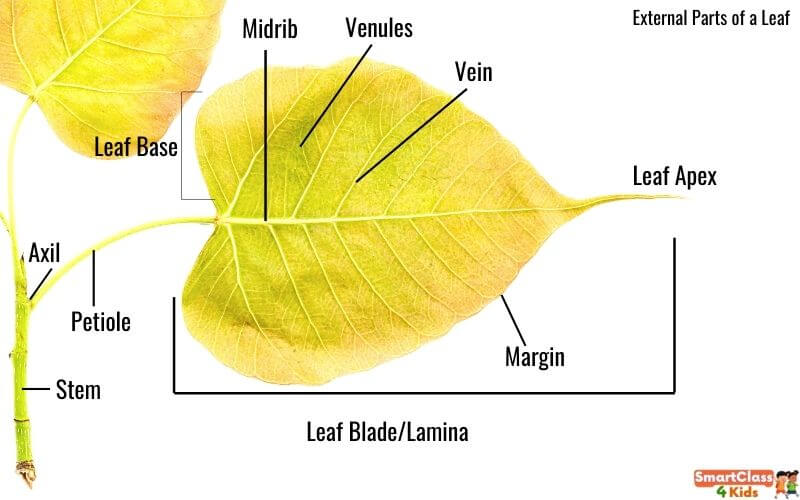Parts of a Leaf
In this article, you will learn about the definition of a leaf, parts of a leaf, types of leaves and the main functions of leaves.
Definition of a leaf
The leaf is one of the most important parts of a plant. Leaves are responsible for producing food for the plant through a process called photosynthesis. The leaves of different plants vary widely in size, shape, and color.
External Parts of a Leaf

There are mainly three parts of a leaf:
- Leaf Base,
- Petiole
- Lamina
Petiole: The thin stalk with which leaf is attached to the stem is called petiole. The petiole is commonly known as leaf stalk.
Not all leaves have petioles. The leaf with petiole is called Petiolated. The leaf without petiole is called Stalkless or Sessile.
Functions of Petiole:
- It holds the leaf to the stem
- It helps in transporting water and nutrients absorbed by the roots to the leaves.
- Helps to transport prepared food ( photosynthetic products) from the leaves to the rest of the plant.
- Helps trees lose their leaves in the fall.
Lamina: The lamina is the flat and green part of the leaf with veins and veinlets. Lamina is commonly known as Leaf Blade. The photosynthesis process occurs on this part of the leaf.
Lamina is further divided into these parts:
- Leaf Apex – the tip of the leaf blade,
- Leaf Margin – the boundary (edge) of the leaf and,
- Main Leaf Veins – In the middle of the lamina (leaf blade), a prominent mid-rib or main vein connects with the petiole.
- Secondary Leaf Veins: The veins branching from the primary vein are called secondary veins.
Functions of Lamina:
- The primary function of the lamina is photosynthesis.
- Performing evaporation by the process of transpiration
What is Venation?

The arrangement of veins and the veinlets in the lamina of the leaf is called venation. You can see different types of venation in different plants. But generally, there are TWO types of venation.
Reticulate Venation: When the veinlets are irregularly arranged and form a network called reticulate venation. E.g. Hibiscus, papaya, leaves of Basil, Coriander, China Rose.
Parallel Venation: When the veins run parallel to each other, called Parallel Venation. E.g. Mango, hibiscus, ficus.
Types of Leaves

Simple Leaves
It is a single leaf with undivided lamina that are directly attached to the stem. In other words, there are no incisions or cuts in the lamina.
Even if there are minor divisions, they do not touch the midrib and divide the lamina.
Examples: Maple, oaks, banana, guava, mango etc.
Compound Leaves:
The leaf lamina is divided into many small pieces attached to the midvein and having its stalk. Each piece is called a leaflet. Leaflet differs from a leaf by not having an axillary bud.
Examples: Neem, rose, clover, desert cotton, poison ivy etc.
The compound leaves again divided into two types:
Pinnate Compound Leaf: Leaflets are present on a common axis, the rachis. E.g. Neem
Palmate Compound Leaf: The leaflets are attached at a common point, i.e. at the tip of the petiole. E.g. Silk Cotton.

Functions of Leaves
Photosynthesis:
The leaves make food for the plant by the process of photosynthesis. The leaf is also known as the food factory of the plant.
The leaves contain chloroplast, which is filled with a green pigment called chlorophyll. Leaves use this green pigment to produce food by converting the energy in sunlight, water and carbon dioxide into chemical energy that the plant can eat.
During that process, the leaves absorb Carbon Dioxide from the environment and return oxygen back to the atmosphere. [more on photosynthesis]
Transpiration:
Plants keep absorbing water from the soil all the time through the root. Plants use some of the water in the process of making food. The excess water evaporates from the surface of the leaves through stomata. This process of water removal is called transpiration.
Guttation:
Guttation is when the excess water is removed not from the stomata but the xylem at the edge of the leaves. Guttation happens when a stomata is closed.
Storage of food:
In some plants, the leaves are modified to store food, e.i. Onion. For this purpose, leaves are thick and fleshy.
Exchange of gases:
Gaseous exchange such as oxygen and carbon dioxide takes place through the stomata present on the leaves.
Key Points: Parts of a leaf, types & functions
- Leaves are found at the nodes of the stem and are responsible for preparing food for the plant through photosynthesis.
- Leaves contain the photosynthetic pigment called chlorophyll.
- There are three main parts of a leaf – Leaf base, leaf lamina, and petiole.
- There are two basic types of leaves – simple leaves and compound leaves.
- The other types of leaves include linear, ovate, oblong, acicular, reniform, lanceolate, orbicular, rhomboid, elliptical, oblique, centric cordate, etc.
- Simple leaves: no incisions or cuts in the lamina
- Compound leaves: lamina is divided into many leaflets
- Compound leaves are further classified into two types: Palmately compound leaf and Pinnately compound leaf
- Palmately compound: Leaflets are present on a common axis, called rachis
- Pinnately compound leaf: Leaflets are attached at a common point, at the tip of the petiole.
- The arrangement of veins in a leaf is called the venation. Mainly there are two types of venation: parallel venation and reticulate venation.
- Main functions of leaves: photosynthesis, transpiration, guttation, storage of food, exchange of gases
